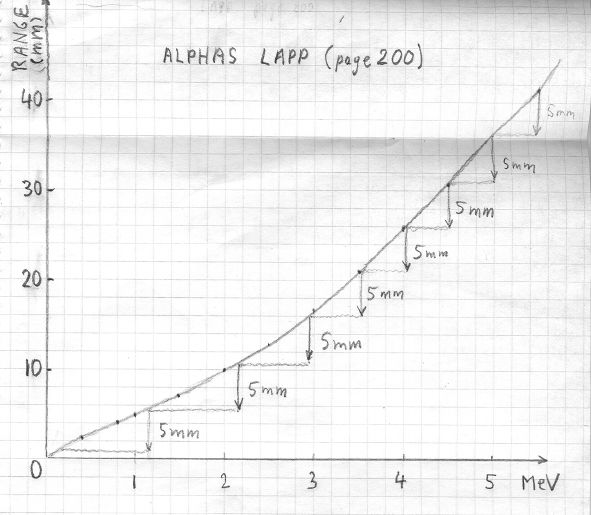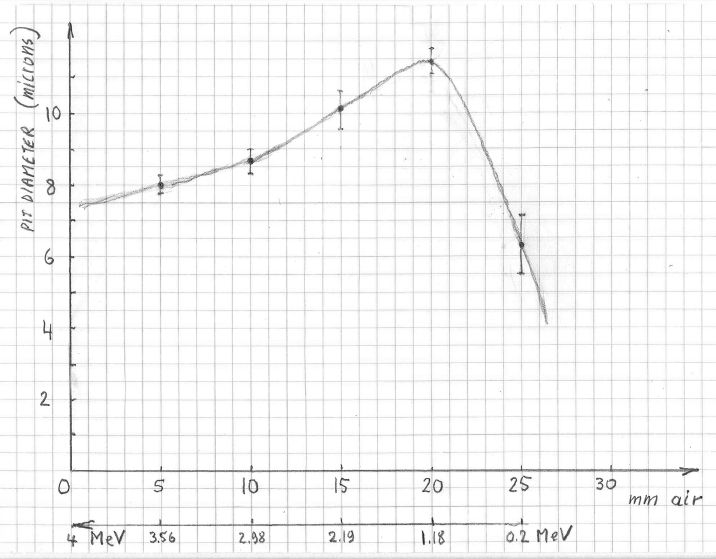Click to see the list of links
324) Defending my APS conclusion
Ludwik Kowalski; 4/23/2007
Department of Mathematical Sciences
Montclair State University, Montclair, NJ, 07043
1) Unit #323 was an attempt to defend the conclusion that prominent SPAWAR pits could not be due to alpha particles or lighter nuclear projectiles. The defence
was based on an experiment whose purpose was to show that diameters of pits due to alpha particles decrease at very low energies. But that was an experiment
belonging to the quick-and-dirty category. It was good enough to convince me (that the claim made in unit #319 was valid) but probably not good enough to convince
others. A much better experiment was finished today. The results are more or less consistent with what has been reported in 2000 -- the diameters of pits due to
alpha particles decrease when energies of alpha particles become samller than approximately 1 MeV. This is illustrated in Figure 1 below.
- - - - - - - - - - - - - - - - - -

Figure 1
Dependence of pit diameters (in microns) on energies of alpha particles (in MeV), as reported in 2000 (at ICCF8) by Roussetski. His important report can be
downloaded from the library at <http://www.lenr-canr.org>.
- - - - - - - - - - - - - - - - - -
Using our Am-241 source, from a smoke detector, six chips were exposed to alpha particles, one after another. The distance between the source and the CR-39
detector (in air) was different for each chip as summarized in the table below. The exposure times were adjusted on the basis of the
1/r2 dependence.
dist (mm). .mean diameter (microns) . . st. dev. (microns). ~ E (MeV) 5. . . . . . .8.0 . . . . . . . . . . . .0.53 . . . . . . . . 3.56 10 . . . . . . 8.8 . . . . . . . . . . . .0.62 . . . . . . . . 2.98 15 . . . . . .10.3 . . . . . . . . . . . .0.90 . . . . . . . . 2.19 20 . . . . . .11.0 . . . . . . . . . . . .0.74 . . . . . . . . 1.18 25 . . . . . . 6.3 . . . . . . . . . . . 1.85 . . . . . . . . 0.20 30 . . . . . only background tracks could be seen for that distance.- - - - - - - - - - - - - - - - - -
 Figure 2
Figure 2Dependence of the mean range of alpha particles in air (in mm) on their energies (in MeV).
- - - - - - - - - - - - - - - - - -
The next figure shows how the mean diameters of pits depend of the distance in air. The etching was in 6.25 NaOH, at 73 C, for 5.75 hours. For each distance 20 tracks were randomly selected and their diameters were measured. The points in Figure 3 are mean values while the error bars are standard deviations. Note that energies become smaller when distances become larger. Rapid decrease of diameters, at energies below 1 MeV is in very good agreement with the dashed line in Figure 8 of unit #319. That is why I think that this experiment validates the controversial conclusion made at the APS meeting (see unit #319).
- - - - - - - - - - - - - - - - - -
 Figure 3
Figure 3Dependence of the mean diameters (microns) on the distance from the source in air (cm). According to Figure 2, if alpha particles emerging from the source into air had the energy of 5.5 MeV then the maximum diameters would be near the distance of 35 mm. The shallow tracks, in that case, would be seen at 40 mm, and not at 25mm.
- - - - - - - - - - - - - - - - - -
Inserted on 4/24/07:
The following message was posted (three days ago) on the private list for CMNS researchers. I do not know how to interpret the fact not not a single Galileo Project researcher responded so far.
“It is important not to get lost in details. What do we want to accomplish? A claim was made, 18 years ago, that a nuclear activity of some kind can be induced by a chemical process. Many highly qualified scientists confirmed the validity of such claim. They measured amounts of thermal energy produced, they counted light nuclear projectiles, such as alpha particles, they showed that tritium, helium and heavier isotopes were produced [and destroyed] during some chemical reactions. What we need is a protocol for a simple, reproducible-on-demand test --we need an experiment to convince honest skeptics that a nuclear effect can indeed by induced by a chemical process.
The Galileo Project is an attempt to convince ourselves that the SPAWAR effect is an example of CANR (chemically assisted nuclear reaction). As demonstrated in the EarthTech report, based on a large number of experiments, the SPAWAR pits are quite easy to observe. Seven teams, studying the SPAWAR effect at the same time, should produce seven yes or no answers about reality of a particular kind of CANR. So far only two Galileo Projects (beta 2 and beta 5) have been completed. Their answers seem to be negative. When will we know about conclusions reached by remaining teams? The Galileo Project will become a missed opportunity unless all outcomes are reported. Please report the status of your project on this list, even if your work is still in progress.”
The Galileo Project Team #2 conducted many experiments and their reseults are posted at <http://earthtech.org/CR39/>
Inserted on 4/24/07:
The corresponding curve for protons has the same general shape as the curve for alpha particles (see Figure 1 above), as illustrated by Steve Krivit in
http://newenergytimes.com/Reports/Krivit-KowalskiCR-39Discussion.htm
It was shown by the MIT team. Experimental details can be found in their report. According to the Internet, that report was published in Rev. Sci. Instrum. 73 (2002) 2597. But I did not check this. I simply went to Google, entered the "A modified accelerator for ICF diagnostic development" into the search box, and clicked on the first link to download the pdf file.
Inserted on 4/26/07:
a) The distances between the Am-241 source and the CR-39 chips were determined by numbers of iron nuts, each 5 mm thick, mounted on each other to support a detector. Alpha particles traveled along a tube formed by nuts. But energies in Figure 3 were estimated by using the range-energy relation. If I had a silicon detector I would measure energies as well. If the energy at d=5 mm were found to be 4.5 MeV, for example, rather than 4.0 MeV, then the energy scale in Figure 3 would changed accordingly. My subjectively estimated uncertainty (the location of 4.0 MeV with respect to d=0) is plus or minus 0.5 MeV.
b) Fortunately, such uncertainty does not weaken the initial conclusion -- pits whose diameters are 2.5 times larger than those due to alpha particles of Am-241 cannot possibly be due to alpha particles or lighter projectiles. Unfortunately, no comments concerning that conclusion have been posted on the CMNS list so far. I do not know how this should be interpreted. Does it mean that most subscribers consider my conclusion to be obvious or does it mean they did not read this unit? The posting of the unit was announced on the list and the URL was given. Steve Krivit was also informed about this unit.
c) Using a silicon detector to measure energies directly would increase the accuracy, in comparison with the method I used. And it would have another advantage; in addition to mean energies the distribution of energies would also be known. The ideal way to calibrate the CR-39 would be to use nearly mono-energetic particles form an accelerator. That approach was described in the 2002 paper of Roussetskii et al., downloadable from the library at http://lenr-canr.org .
d) My simple study was undertaken because I wanted to know what happens to pit diameters at very low energies. I was not aware of the existence of the curve shown in Figure 1 above. The location of the maximum on that Figure does not coincide with the location of the maximum in Figure 3. At least part of the difference is due to limited accuracy of two experiments. Fortunately, my conclusion about copious SPAWAR pits does not depend on the location of the maximum, it depends only on the relative sizes of pits at the maximum, in comparison with sizes of pits due to alpha particles from the Am-241 source.
Appended on 4/27/07:
Hmm, patent protection? If I were motivated by a patent I would unsubscribe from the CMNS list and would not talked at ICCF conferences. The list, as far as I know, consists mostly of people whose motivation is scientific. We are interested in the main CF claim -- a nuclear process, such as emission of neutrons or alpha particles, can be induced by a chemical process, such as electrolysis or diffusion. This is not patentable. The sounding board function is as important to us as the peer review is important to readers of a traditional journal.
Click to see the list of links